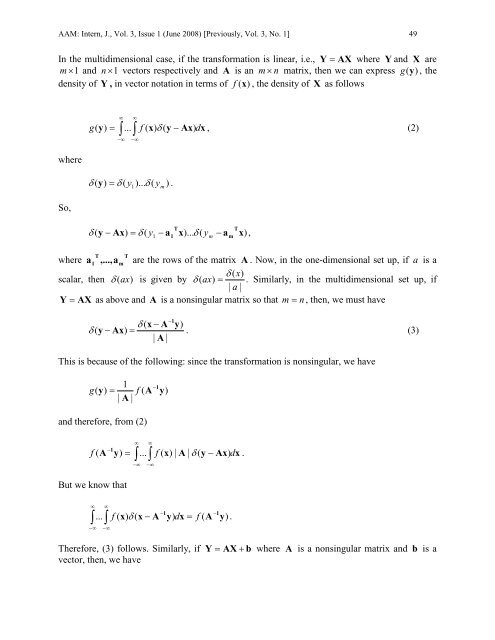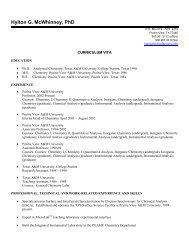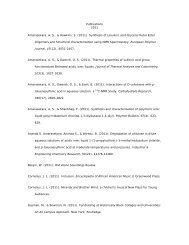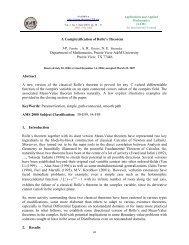Some applications of Dirac's delta function in Statistics for more than ...
Some applications of Dirac's delta function in Statistics for more than ...
Some applications of Dirac's delta function in Statistics for more than ...
Create successful ePaper yourself
Turn your PDF publications into a flip-book with our unique Google optimized e-Paper software.
AAM: Intern, J., Vol. 3, Issue 1 (June 2008) [Previously, Vol. 3, No. 1] 49<br />
In the multidimensional case, if the trans<strong>for</strong>mation is l<strong>in</strong>ear, i.e., Y = AX where Y and X are<br />
m × 1 and n × 1 vectors respectively and A is an m × n matrix, then we can express g (y)<br />
, the<br />
density <strong>of</strong> Y , <strong>in</strong> vector notation <strong>in</strong> terms <strong>of</strong> f (x)<br />
, the density <strong>of</strong> X as follows<br />
where<br />
So,<br />
∞<br />
g ∫ ∫<br />
( y) = ... f ( x)<br />
δ ( y − Ax)<br />
dx<br />
, (2)<br />
−∞<br />
∞<br />
−∞<br />
δ y ) = δ ( y )... δ ( y ) .<br />
( 1 m<br />
δ ( y − Ax)<br />
= δ ( y1 − a1<br />
x)...<br />
δ ( ym<br />
− am<br />
x)<br />
,<br />
T<br />
1<br />
T<br />
m<br />
T<br />
T<br />
where a ,..., a are the rows <strong>of</strong> the matrix A . Now, <strong>in</strong> the one-dimensional set up, if a is a<br />
δ ( x)<br />
scalar, then δ (ax)<br />
is given by δ ( ax)<br />
= . Similarly, <strong>in</strong> the multidimensional set up, if<br />
| a |<br />
Y = AX as above and A is a nons<strong>in</strong>gular matrix so that m = n , then, we must have<br />
−1<br />
δ ( x − A y)<br />
δ ( y − Ax)<br />
=<br />
. (3)<br />
| A |<br />
This is because <strong>of</strong> the follow<strong>in</strong>g: s<strong>in</strong>ce the trans<strong>for</strong>mation is nons<strong>in</strong>gular, we have<br />
1 −1<br />
g ( y)<br />
= f ( A y)<br />
| A |<br />
and there<strong>for</strong>e, from (2)<br />
∞<br />
A y x A y Ax x<br />
1 −<br />
( ) = ... f ( ) | | δ ( − ) d .<br />
f ∫ ∫<br />
But we know that<br />
∞<br />
−∞<br />
∞<br />
∫ ∫<br />
−∞<br />
∞<br />
−∞<br />
−1<br />
−1<br />
... f ( x)<br />
δ ( x − A y)<br />
dx<br />
= f ( A y)<br />
.<br />
−∞<br />
There<strong>for</strong>e, (3) follows. Similarly, if Y = AX + b where A is a nons<strong>in</strong>gular matrix and b is a<br />
vector, then, we have
















